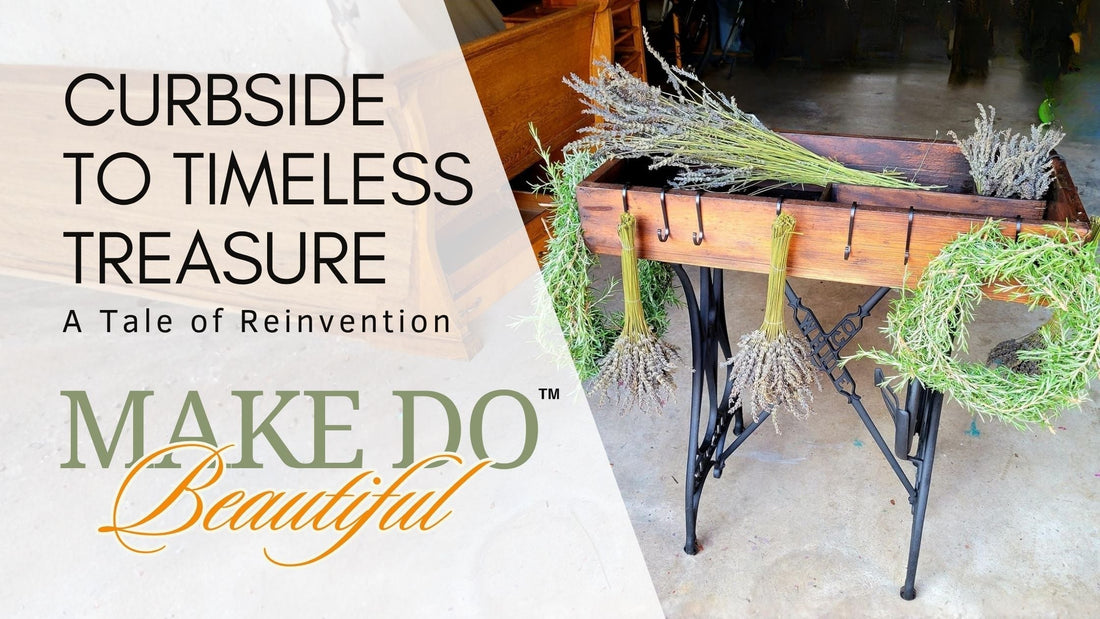
From Curbside Find to Timeless Treasure: Upcycling an Old Sewing Machine Table Base
In the quiet of San Carlos, California, a beautiful old cast iron base was waiting for me. I found an antique sewing table abandoned on the curb, and the ornate metal instantly drew me in, hinting at a history that was ready for its next chapter.

After a little research, I discovered it was a White S.M. Sewing Co. table—one of the first electric models, meaning it didn’t have the usual treadle. I was drawn to its streamlined design, which gave the elegant metal base cleaner lines. I knew I had found a true gem for an upcycled furniture project.
I carefully dismantled the wooden cabinet, and the small drawers quickly found a new home in our living room, offering a touch of soulful, rustic charm. But the cast iron base—the piece that held the most potential—remained in my garage, patiently waiting.

A year later, a big change came into our lives. We moved across the country to Urbana, Maryland—a cross-country leap that, much like the sewing table's transformation, pushed us to embrace a new rhythm and find beauty in the unknown. This journey, rooted in creative living through repurposing, taught me that sometimes, all it takes is a new location to spark a fresh idea.
Then, one day, while on a walk, I stumbled upon a second curbside find: a very large, solid wood drawer, weathered but full of promise. It felt like fate; the perfect match to complete the repurpose antique cast iron base idea I’d had!

Restoring Cast Iron Table Base for a New Life
We got to work immediately. For the wooden top, a touch of dark stain brought out the drawer’s beautiful patina, and a matte finish sealed its rustic character. For the metal base, maintaining its integrity was key to our restoring cast iron table base process. We banished the rust, revived the original castors with WD-40, and coated it in a fresh, matte-finish, made-for-metal paint.

The final piece is a beautiful reminder that when we combine history and creativity, we can transform everyday materials into something beautiful and purposeful. Now, this transformed piece has a special place in my home, serving multiple purposes—whether it's displaying collected treasures, transporting freshly cut herbs from the garden, or simply adding a touch of cozy character to a room. It truly is a unique DIY sewing machine table idea.
This journey reminds us that beauty and utility can be found in the most unexpected places. Start with what you already have, or try a walk around the neighborhood—you might be surprised what’s right in front of you, waiting for a new chapter in its story.

Let's try it your way! Do you have an old piece of furniture with a great story, or have you completed your own upcycling old sewing machine table project? I would love to see how you're embracing creativity and conscious consumption in your own space. Share your thoughts or experiences with us in the comments below! We're all in this journey of meaningful living, together.
Frequently Asked Questions
How do I clean rust off a cast iron sewing machine base?
You can gently remove rust using a wire brush or steel wool. For heavier rust, a vinegar soak or a commercial rust remover followed by careful sanding can work well.
What can I make from an old sewing machine table?
Repurposing an antique cast iron base is perfect for creating a beautiful console table, a unique bathroom vanity, a potting bench, or even a small, decorative vintage sewing machine base desk.
Is it worth upcycling an antique sewing machine base?
Absolutely! Upcycling preserves a piece of history, is a sustainable choice, and results in a unique, story-driven piece that adds soulful character to your home.
How can I safely dismantle an old sewing machine cabinet?
Most cabinets are held together with screws or basic bolts. Disconnect the treadle (if present) and the machine head from the cabinet top, then separate the wooden cabinet from the cast iron sewing machine base.
What paint is best for a cast iron table base?
Use a paint specifically made for metal. Look for a rust-inhibiting primer first, followed by a durable enamel or 'for-metal' paint, often available in a matte or satin finish to maintain a vintage feel.
Where can I find unique items for upcycling projects?
Start with what you already have, then try checking local curbsides, estate sales, flea markets, and thrift stores. You never know what beautiful pieces are waiting to be collected and given a new life!

